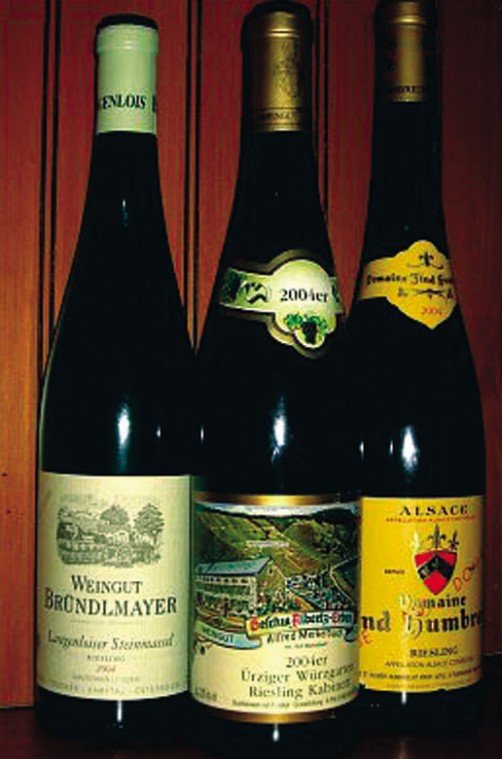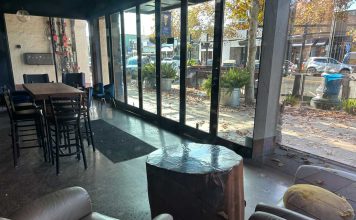Our wine and dinner group gathered again last month. We have
traveled around to many places in the wine world and it was decided
that we would make our next stop examining rieslings from Germany,
Alsace and Austria.
Our wine and dinner group gathered again last month. We have traveled around to many places in the wine world and it was decided that we would make our next stop examining rieslings from Germany, Alsace and Austria.
Rieslings have long been considered some of the most misunderstood wines in the world. They also have been considered the most versatile white wine made today, pairing nicely with an array of foods, including spicy Thai noodles, curries, sushi, fish, chicken and pork.
Let’s start by understanding some riesling variations: Kabinett is very light, crisp and slightly sweet; Spatlese, meaning late harvest, can be sweet or dry and ages well; Auslese are made from riper grapes, with some residual sugar; Eiswein comes from grapes with high levels of concentrated sugar and acidity, which occurs from the grapes being frozen on the vine. There are other kinds, but these are the most popular.
Our first wine was a 2004 Alfred Merkelbach – Kabinett – Ürziger Wurzgarten from Germany. This wine was slightly sweet, soft, crisp and layered with apple flavor. As you will see, we tried numerous wines and this ended up being one of my favorites. It was very low in alcohol, around 7.5 percent, and I started to call this my “Lay’s Potato Chip” wine – there is no way anyone could only take one sip. The cost per bottle was around $15.
The next two wines were also from Germany, a 2001 Hexamer – Spätlese – Nohe and a 2001 Strub – Spätlese – Niersteiner Oelberg. The Hexamer was more acidic than the Kabinett, with nice citrus and grapefruit aromas. The Strub was slightly sweeter, also with good acidity – the trademark of a nice Spätlese. Each wine was again low in alcohol, 7.5 and 9.5 percent respectively, and both were around $17.
Our host wanted to provide a nice balance of appetizers to pair with the rieslings. For the chilly weather, winter vegetables of baby carrots, broccoli and cauliflower were lightly steamed and then plunged into ice water to stop the cooking process. The vegetables, served chilled, had nice texture – not fully cooked, not raw. A homemade dip consisting of yogurt, mayonnaise, cream cheese, parsley, Dijon mustard, chives and lemon juice was served on the side. Rice crackers, sweet baguette bread, sliced pork sausage, French goat cheese, California brie, petite Basque cheese, grape tomatoes with salt, cracked pepper and lemon juice and (insert drool here) pan-fried thick cut bacon. Like a Pavlovian dog, mention the word bacon, and I start to salivate. My physician would be appalled, but I started to wrap the bacon around pieces of the petite Basque cheese, folded them into the baguette slices and consumed these mini-sandwiches at a frenetic pace.
Another member of the group saw what I was doing and started to imitate my behavior. “I went and had my teeth cleaned today, specifically for this,” he exclaimed!
As we continued to gorge and prepare for the main course ahead, our group moved into a few wines from Austria.
The first Austrian wine was a 2005 Summerer – Urgestein Longelois; the second, a 2005 Baurel – Trocken – Wachau. The Summerer showcased the minerals and dry, acidic components that many Austrian rieslings are known for. The Baurel was the most austere wine of the group, with a chalky, dry, almost tart finish. Both of these wines were under $20.
Our final two wines prior to the main course were two wines from the Alsace region. Some say that the soul of Alsace will always be French, even though the language and its markets may be German.
The first Alsace wine was a 2004 Zind Humbrecht – Turckheim. The essence of this wine reminded me of champagne, albeit without the natural carbonation. The wine was acidic and dry. It was sweet on the palate in the beginning but with a tart finish.
The other was a 2004 Ostertag – d’Epfig. I had previous exposure to this wine prior to the dinner, so I was familiar with the producer. The Ostertag was crisp and refreshing, with hints of lemon. It had an opaque, light straw color to it. This can be expected of young rieslings. As rieslings age, up to 20 or even 30 years depending on the producer, the wine turns a darker, caramel color. They also tend to become more minerally and even pick up an oily, kerosene-like compound. The Alsace wines were low in alcohol and reasonably priced at $18 each.
Next week, we’ll talk about the main course and the other wines we enjoyed that evening.
Cheers!












